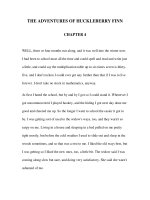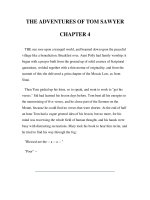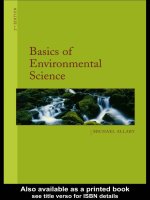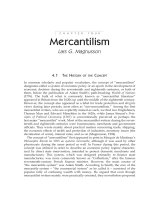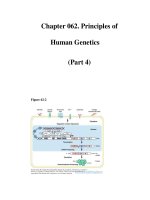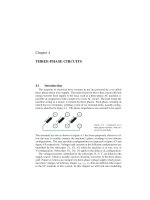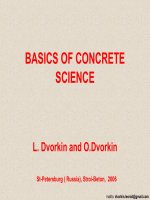BASICS OF CONCRETE SCIENCE - CHAPTER 4 ppsx
Bạn đang xem bản rút gọn của tài liệu. Xem và tải ngay bản đầy đủ của tài liệu tại đây (420.38 KB, 17 trang )
CHAPTER 4
CONCRETE STRENGTH
L. Dvorkin and O.Dvorkin
71
Strength is a property of materials to resist to destruction under action of
the external loading.
4.1. Theories of strength and mechanism
of destruction
The existing theories of concrete strength are divided into three
groups: phenomenological, statistical and structural.
Phenomenological theories consider concrete, as homogeneous
isotropic material. All attention is paid to dependence of strength on
the external loading, they set reasons on which it is possible to judge
about beginning of material destruction at the tense state, if the
behavior at simple tension, compression or shear is known.
72
Fig. 4.1. Chart of destruction of
easily broken material at the
axial compression if there is
default of friction on supporting
flags of the press
According to statistical theories
the existence in the concrete of
continuous isotropic environment,
in which there are microscopic
cracks (conformable to the
statistical laws) is also assumed.
These theories allow to explain
enormous distinction between
theoretical and actual strength,
determined by the defects of
structure of substance, without
consideration of structure.
73
Development of crack under action of the attached compression takes place
at reduction of general energy of the system. Stability Criterion of easily
broken material with a crack: can be calculated by the following formula:
(4.1) ,/Е2 lπν=σ
where σ- the attached compression; E- modulus of elasticity;
ν- surface energy; l- length of crack.
In accordance with the statistical theory of the strength (from Weibull)
tensile and flexural strength (R) changes inversely proportional to a
volume υ:
(4.2) ,
А
R
m/1
υ
=
where m – degree of homogeneity of material, taking into account the
character of defects distributing; A – constant value.
74
Development of structural theory of concrete strength began at the end of
the 19 century after establishment by Feret dependence between strength of
concrete and density of cement paste, modified late by Powers taking into
account the level of cement hydration. The Feret dependence became a
basis for development of Abram's law (rule of water-cement ratio) - the
fundamental dependence used at the calculation (proportioning) of concrete
mixtures.
In accordance with Powers compressive strength (R) of the specimens of a
different age and made at a different water-cement ratio can be calculated
from:
(4.3) ,АХR
n
=
where X- ratio between volume of cement hydrate gel and the sum of
volumes of cement gel and capillary space; A- coefficient characterizing
strength of cement gel; n- constant (from 2.6 to 3).
The parameter Х can be considered as a relative density of cement paste
(stone).
75
Fig. 4.2. Relationship between compressive
strength (R
cmp
) and middle size of pores of
cement paste (stone)
Middle radius of pores (r⋅10
-10
m)
R
cmp
, MPa
76
The condition of development of crack in concrete can be determined from
Griffith and Orovan formula:
(4.4) ,kdd/Е
2/1
срср
−
=ν=σ
where σ- tensile stress; E- modulus of elasticity; ν- effective energy of
destruction; d
as
- average size of a crystal;
(
)
2/1
Ek
−
ν=
- coefficient of viscidity of destruction.
Strength of concrete depends on deformations arising up at loading.
77
Fig. 4.3. Relationship of strength of the cement
stone R
c.s
and average size of crystals d
as
ср
d
as
, 10
-
6
m
R
c.s
, MPa
78
4.2. Law (rule) of water-cement ratio
The fundamental works of Feret, Abrams, Bolomey and other researchers
determined wide application in practical technology of the water-cement
(W/C) law (rule) and based on it computation formulas.
After processing results more than 50 thousand tests, Abrams offered a
formula:
(4.5) ,
A
k
R
x
=
where R- strength of concrete; k – strength coefficient, A – constant value,
x – ratio between volume of water and volume of cement.
Graf offered at the end of 20
th
years of 20 century the formula of
concrete strength (specifying the Abrams formula for practical
calculations) as follows:
()
(4.6) ,
C/WА
R
R
n
c
=
where R
c
– compressive strength of portland cement; А and n -
coefficients (from Graf А=4 8, n=2); W/C – water-cement ratio.
79
Bolomey (based on Feret dependence) determined a formula:
(
)
(4.7) ,5.0W/CКR
−
=
where R- strength of concrete; C/W– cement-water ratio;
K- coefficient.
After treatment of experimental researches B.Skramtaev and
Y.Bagenov offered the formulas of concrete strength :
If C/W≥2.5
If C/W≤2.5
(
)
(4.8) ,5.0W/CАRR
c
−
=
(
)
(4.9) ,5.0W/CRАR
c
1
+=
where R- concrete strength; C/W– cement-water ratio; A and A
1
-
coefficients.
80
Fig. 4.4. Typical relationship between strength of
concrete (R), strength of cement (R
c
)
and cement-water ratio (C/W)
C/W
R/R
c
81
4.3. Adhesion between aggregates
and cement stone
Aggregates, making the bulk of concrete and forming the
concrete structure as composite material, actively affect
concrete strength foremost through strength of adhesion of
cement paste (stone) with their surface.
Gordon produced the test of different kinds of aggregates.
Strength distinctions of concrete arrived at 50%.
82
Fig. 4.5. Relationship between
volume of aggregates in the
volume of concrete (V
ag
) and
compressive strength (R) of
concrete:
1 – complete coupling of
aggregates and cement paste;
2 – coupling is fully absent
V
ag
R, MPa
83
4.4. Influence of terms and duration
of hardening concrete
Concrete strength in definite age is determined in accordance with
Skramtaev formula:
(4.10) ,
28lg
nlg
RR
28n
=
where n – duration
of concrete
hardening, R
28
–
concrete strength at
28 days.
Fig. 4.6. Increasing of strength of concrete (R)
in wet (1) and dry (2) conditions
Age
28 days
1 year
2
4
6
11 years
R, MPa
84
Fig. 4.7. Increasing of strength of fresh concrete during 28
days at temperature (t) from +20 to –10
0
C
Compressive strength, %
of 28 day concrete
Temperature of curing,
0
C
Fig. 4.8. Typical relationship between strength
and duration of curing for different conditions:
1- moist (normal) curing; 2- curing in live stream at
atmospheric pressure (80
0
C max. steam temperature);
3- curing in high-pressure-steam autoclaves
Age, days
Compressive strength, % of 28-day
moist (normal) - cured concrete
85
4.5. Kinds of strength. Tests for concrete strength
The main kind of strength concrete is compressive strength that
correlates with tensile strength, shear strength, flexural strength
and other kinds of strength.
The values of concrete strength are greatly influenced by the
features of tester machines, conditions of test, and form of
specimens.
Various nondestructive tests (rebound, penetration, pullout,
vibration and other methods) are widely used in practice for
determination of strength of hardened concrete based on
relationship between strength and indirect evaluations.
For strength evaluation of hardened concrete by nondestructive
methods calibration charts are used, which related by measured
indirect evaluation to the compressive strength of concrete.
86
Fig. 4.9. Typical relationship between flexural
strength R
fl
(curve 1), tensile strength R
tn
(curve 2)
and compressive strength (R
cmp
) of concrete
R
fl
, R
tn
, MPa
R
cmp
, MPa
